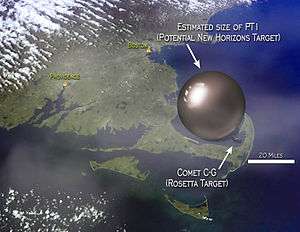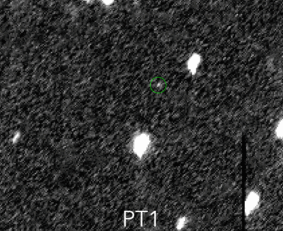2014 MU69
|
New Horizons target, 2014 MU69 (green circles), as it travels across a dense field of stars and noise in the background. Images taken at 10-minute intervals by WFC3 in 2014. | |
| Discovery[1] | |
|---|---|
| Discovered by | Hubble Space Telescope |
| Discovery date | 26 June 2014 |
| Designations | |
| MPC designation | 2014 MU69 |
| MPO364039,[2] 1110113Y,[3] 11,[4] PT1[5] | |
| Classical Kuiper belt object[3] | |
| Orbital characteristics[1] | |
| Epoch 31 July 2016 (JD 2457600.5) [1] | |
| Uncertainty parameter 4[1] | |
| Observation arc | 373 days[1] |
| Aphelion | 45.86 AU[1] |
| Perihelion | 42.69±0.04 AU[1] |
| 44.28 AU[1] | |
| Eccentricity | 0.0358±0.001,[1] 0.036[6] |
| 295 yr[1] | |
Average orbital speed | 4.47 km/s |
| 307.6° [1] | |
| Inclination | 2.4532°±0.0002°,[1] 1.9° [6] |
| 158.933°±0.007° [1] | |
| 179.9°±1° [1] | |
| Physical characteristics | |
| Dimensions |
30–45 km (19–28 mi) [3] 25–45 km (16–28 mi) [4] |
| Albedo |
(albedo ranges assumed) 0.04–0.10 [3] 0.04–0.15 [4] |
| 26.8 [7] | |
| 10.9[1][2] | |
|
| |
2014 MU69 (initially called PT1 and 1110113Y by the New Horizons and Hubble teams, respectively) is a classical Kuiper belt object. It is the target for the New Horizons probe for a flyby on 1 January 2019, after its Pluto flyby.[5] It was selected as New Horizons' target in August 2015.[8] After four course changes in October and November 2015, New Horizons is on course toward 2014 MU69.[9][10]
History
Discovery
On 26 June 2014, 2014 MU69 was discovered using the Hubble Space Telescope during a preliminary survey to find a suitable Kuiper belt object for the New Horizons probe to flyby. The discovery required the use of the Hubble Space Telescope, because with an apparent magnitude of 26 it is too faint for all but the most powerful telescopes. The Hubble Space Telescope is also capable of very precise astrometry and hence a reliable orbit determination.[7][11]
Designation
When 2014 MU69 was first observed, it was labelled 1110113Y,[12] and nicknamed "11", for short.[4][5] Its existence as a potential target of the New Horizons probe was announced by NASA in October 2014[13][14] and it was designated PT1 ("Potential Target 1"). Its official designation, 2014 MU69, was assigned by the Minor Planet Center (MPC) in March 2015 after sufficient orbital information was gathered.[5]
The name 2014 MU69 is a provisional designation and indicates that it was the 1745th object (("U" => 20) + ("69" x 25)) discovered between 16 and 30 June 2014 ("2014", "M").
Characteristics
Based on its brightness and distance, 2014 MU69 is estimated to have a diameter of 30–45 km (20–30 mi).[3] Its orbital period is about 293 years and it has a low inclination and low eccentricity.[15] This unexcited orbit means that it is a cold classical Kuiper belt object which is unlikely to have undergone significant perturbations.[3] Observations in May and July 2015 greatly reduced the uncertainties in the orbit,[7] and the updated orbit parameters are available in the MPC database.
2014 MU69 has a red spectrum, making it the smallest Kuiper Belt Object to have its color measured. [16]
Exploration
Having completed its flyby of Pluto, the New Horizons spacecraft has been maneuvered for a flyby of 2014 MU69, which will occur on 31 December 2018 or 1 January 2019, at which point it will be 43.4 AU from the Sun in the constellation Sagittarius.[17][18][19][20] 2014 MU69 is the first object to be targeted for a flyby that was discovered after the spacecraft was launched.[7]
Gallery



See also
References
- 1 2 3 4 5 6 7 8 9 10 11 12 13 14 15 "2014 MU69 Orbit". Minor Planet Center. 4 July 2015.
- 1 2 "JPL Small-Body Database Browser: (2014 MU69)" (22 October 2014 last obs; arc: 118 days). Retrieved 2015-08-29.
- 1 2 3 4 5 6 Lakdawalla, Emily (15 October 2014). "Finally! New Horizons has a second target". Planetary Society blog. Planetary Society. Archived from the original on 2014-10-15.
- 1 2 3 4 Buie, Marc (15 October 2014). "New Horizons HST KBO Search Results: Status Report" (PDF). Space Telescope Science Institute. p. 23.
- 1 2 3 4 Talbert, Tricia (28 August 2015). "NASA's New Horizons Team Selects Potential Kuiper Belt Flyby Target". NASA. Retrieved 2015-09-04.
- 1 2 Stern, Alan (August 2015). "OPAG: We Did It!" (PDF). Presentation to the Outer Planets Assessment Group (OPAG) of the Lunar and Planetary Institute. Universities Space Research Association. p. 33.
- 1 2 3 4 Lakdawalla, Emily (1 September 2015). "New Horizons extended mission target selected". Planetary Society blog. Planetary Society.
- ↑ Barnett, Amanda (28 August 2015). "Pluto probe gets new assignment". CNN. Retrieved 2015-10-07.
- ↑ Dunn, Marcia (22 October 2015). "NASA's New Horizons on new post-Pluto mission". AP News. Retrieved 2015-10-25.
- ↑ "NASA's New Horizons Completes Record-Setting Kuiper Belt Targeting Maneuvers". New Horizons Team. 5 November 2015. Retrieved 2015-11-06.
- ↑ J. R. Spencer; M. W. Buie; et al. (2015). "The Successful Search for a Post-Pluto KBO Flyby Target for New Horizons Using the Hubble Space Telescope" (PDF). European Planetary Science Congress (EPSC) Abstract. Copernicus Office.
- ↑ "Hubble Survey Finds Two Kuiper Belt Objects to Support New Horizons Mission". HubbleSite news release. Space Telescope Science Institute. 1 July 2014.
- ↑ "NASA's Hubble Telescope Finds Potential Kuiper Belt Targets for New Horizons Pluto Mission". HubbleSite. 15 October 2014.
- ↑ Wall, Mike (15 October 2014). "Hubble Telescope Spots Post-Pluto Targets for New Horizons Probe". Space.com. Archived from the original on 2014-10-15.
- ↑ Porter, S. B.; Parker, A. H.; et al. (eds.). Orbits and Accessibility of Potential New Horizons KBO Encounter Targets (PDF). 46th Lunar and Planetary Science Conference (2015).
- ↑ "Scientists Determine Color of Kuiper Belt Objects JR1 and MU69 | Planetary Science, Space Exploration | Sci-News.com". Breaking Science News | Sci-News.com. Retrieved 2016-11-02.
- ↑ "Maneuver Moves New Horizons Spacecraft toward Next Potential Target". 23 October 2015. Retrieved 2015-11-05.
- ↑ "New Horizons Continues Toward Potential Kuiper Belt Target". 26 October 2015. Retrieved 2015-11-05.
- ↑ "On Track: New Horizons Carries Out Third KBO Targeting Maneuver". 29 October 2015. Retrieved 2015-11-05.
- ↑ "Asteroid 2014 MU69". The Sky Live. Retrieved 2015-11-11.
External links
| Wikimedia Commons has media related to 2014 MU69. |
- 2014 MU69 at the JPL Small-Body Database

